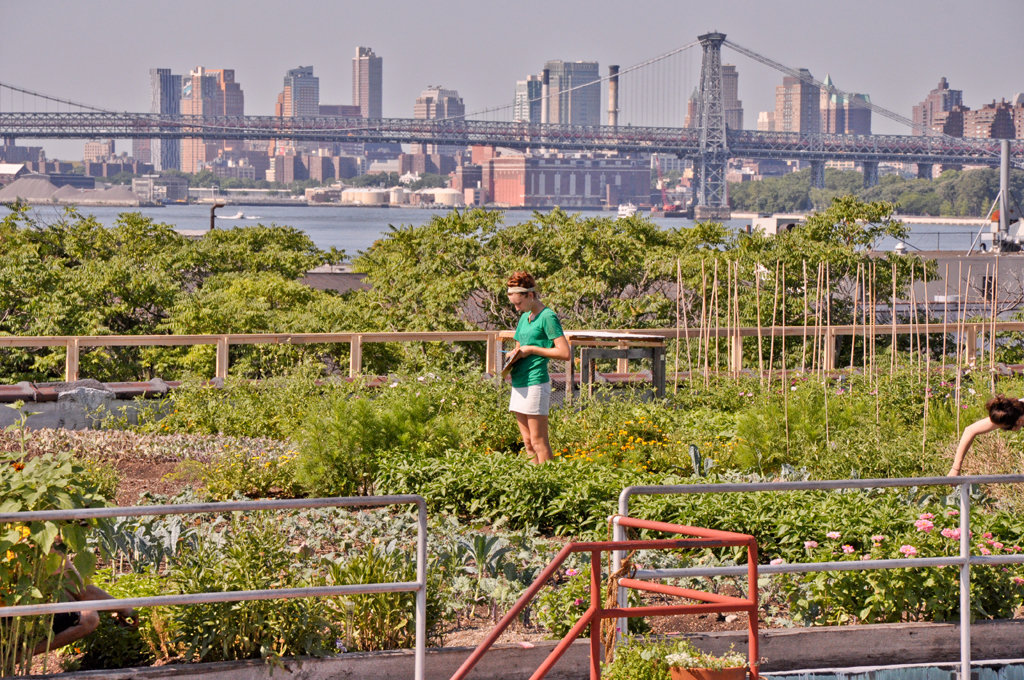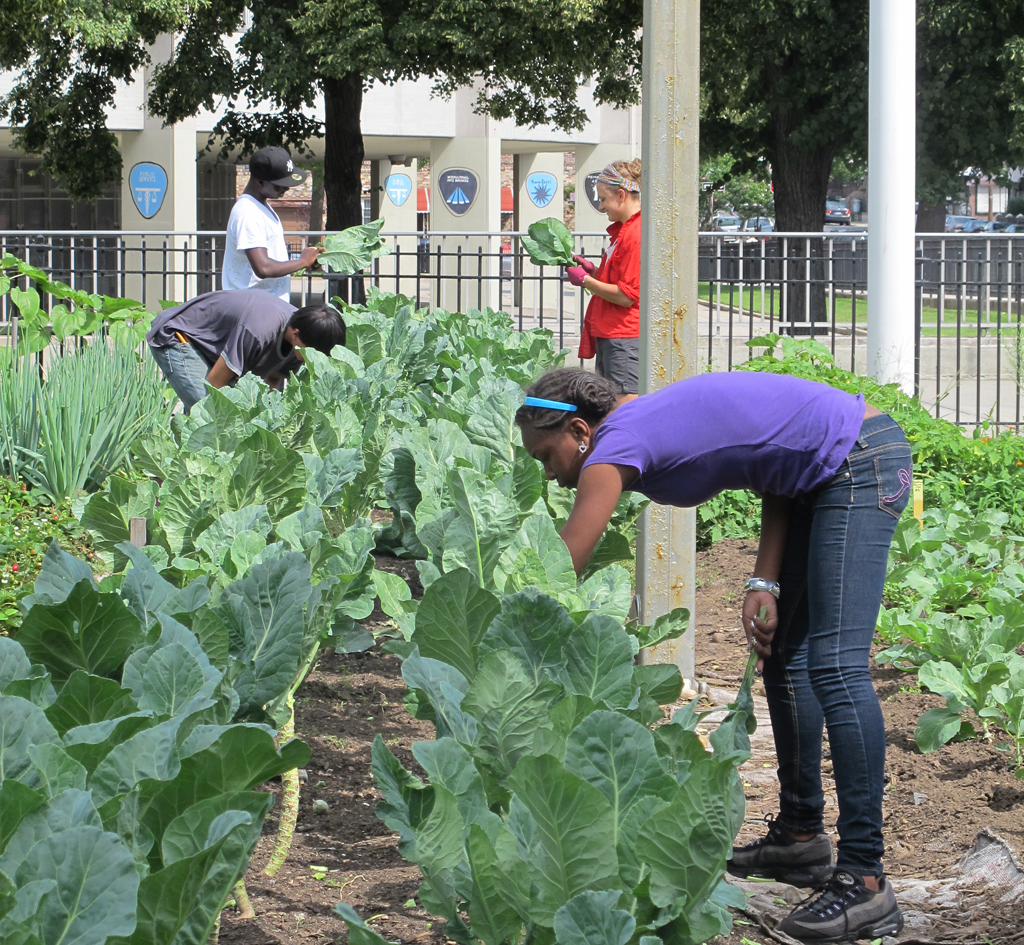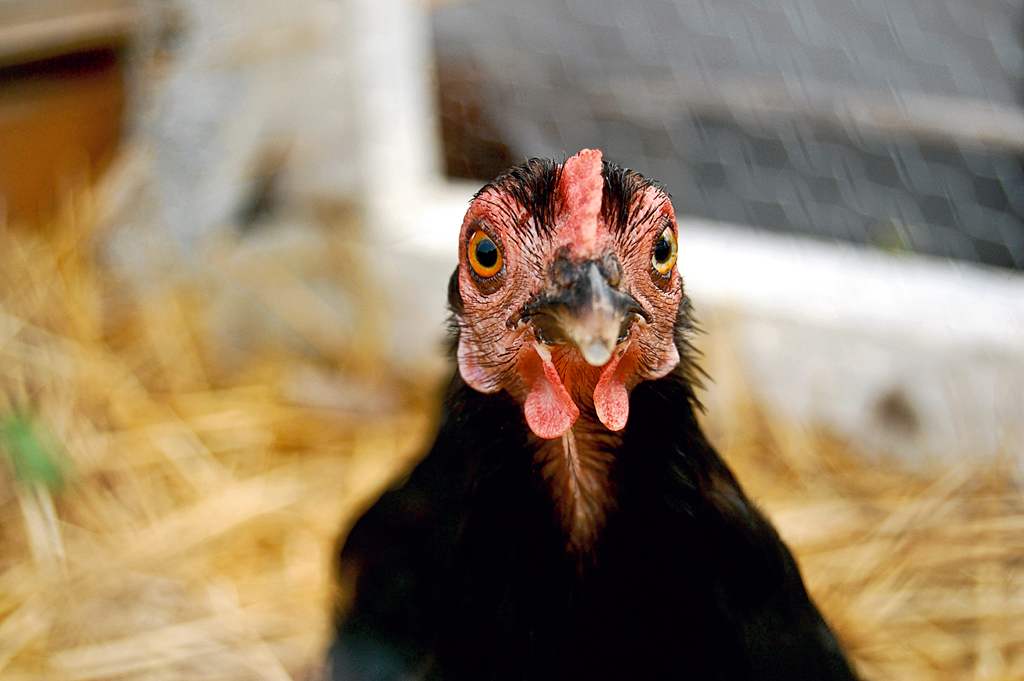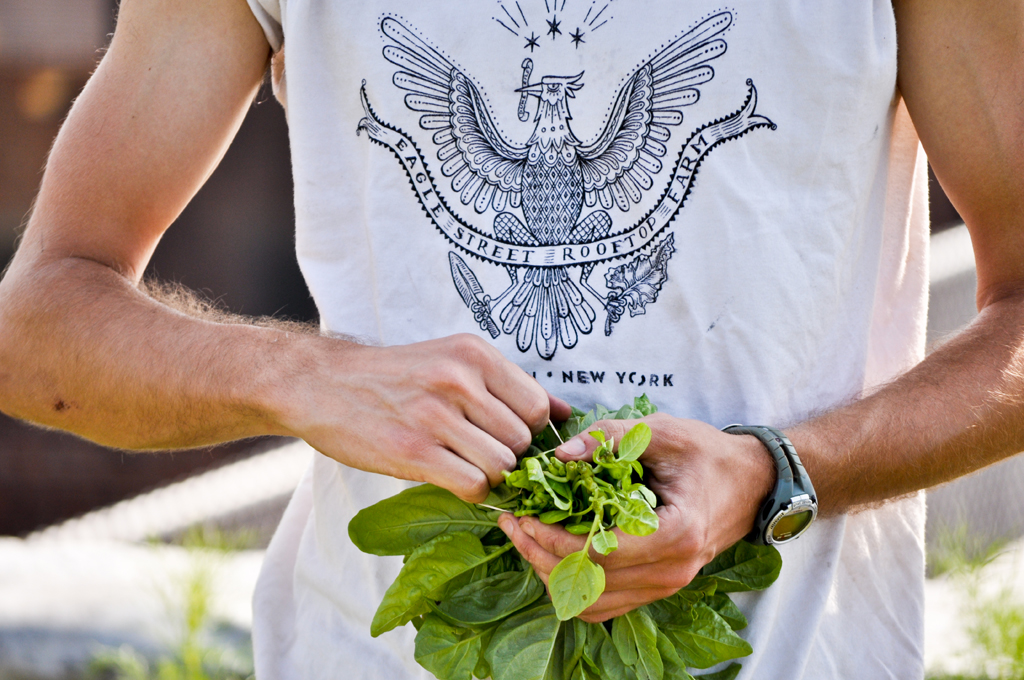
We are celebrating 15 years — and counting — of stories that are deeply researched and deeply felt, that build a historical record of what the city has been.
We are celebrating 15 years — and counting — of stories that are deeply researched and deeply felt, that build a historical record of what the city has been.
How do we measure and communicate the value of urban agriculture? That was the underlying question throughout “Gardener on the Roof: Examining Urban Farming” last Saturday at Union Docs in Williamsburg. The panel presentation and discussion, moderated by Nicola Twilley of Edible Geography, brought together individuals with varied backgrounds (two farmers, two city planners, and an artist) who take three different approaches (scientific research, community outreach, and art) to understanding the place of urban farming in New York City.
Tyler Caruso and Erik Facteau kicked off the event with a presentation of their research on the stormwater management potential of urban farms and their project Seeing Green. Their research aims to measure the environmental benefits of urban agriculture when employed as part of the city’s green infrastructure system, with a focus on the issue of combined sewer overflows (CSOs), a significant problem in New York anytime there is a heavy storm event. In other words, can urban farms contribute to the mitigation of environmental issues in the city in the same way that bioswales and blue roofs do?
The team identified three sites in the city for study, each with a different soil type and growing set-up: Brooklyn Grange rooftop farm in Long Island City, Added Value raised bed farm in Red Hook, and the roof of the NYC Parks Department’s Five Borough Administrative Building on Randall’s Island. By measuring the evaporation and evapotranspiration rates of the soil on two of the sites (they are still raising funds to set up testing at Added Value), Caruso and Facteau are quantifying how much stormwater is retained (permanently absorbed by the soil) and detained (temporarily held in the soil) during a storm, thereby reducing the rush of runoff into the city’s sewer system. The type of soil, planting methods (raised beds vs. in-ground) and differing microclimate conditions all affect the retention and detention potential of the various sites.
Caruso and Facteau hope the results of their project will inform policy decisions made by City officials. They noted there is a lack of data-driven research on urban farms that can help to secure incentives and support from the City compared to other green infrastructure strategies such as green roofs. For example, rooftop farms are currently ineligible for the City’s green roof tax credit, despite providing the same environmental benefits as non-agricultural green roofs. By scientifically quantifying the stormwater effects of urban farms, the team hopes to prove the benefits of the sites beyond their bountiful produce. [Read more about Seeing Green in the February 2012 UO interview with Caruso and Facteau here. –Ed.]
Molly Culver of BK Farmyards, a nonprofit urban farm collective that focuses on food justice, education and job training through urban agriculture, gave a compelling presentation about the ways that the organization is engaging with the community through its Youth Farm program. BK Farmyards operates on plots that are voluntarily offered by landowners, six sites in Brooklyn so far, where they raise vegetables, flowers, chickens and bees. They earn about a third of their income by selling goods through their on-site farmers market, community supported agriculture (CSA) program, and local grocery stores, and by supplying weddings and events.
The Youth Farm, located on a one-acre lot in Crown Heights, Brooklyn, is a partnership between BK Farmyards, the High School for Public Service (HSPS) and Green Guerillas. BK Farmyards runs a Go Green elective course for HSPS 10th graders, in which students learn how to farm and acquire leadership skills by running the Youth Farm weekly farmers market and CSA. In addition to the class, Youth Farm supports an after school farm club, monthly community volunteer days, a student internship program, and an adult apprenticeship program.
The final presentation came from Annie Novak of Eagle Street Rooftop Farm, a 6,000-square-foot organic vegetable farm that sits atop a warehouse in Greenpoint, and photographer and filmmaker Scott Nyerges. Like BK Farmyards, Eagle Street runs an on-site farmers market and CSA, sells produce directly to local restaurants, and offers a number of volunteer and educational programs such as a seasonal apprenticeship program and school tours.
In 2010, Nyerges used the farm as the subject of a year-long photo documentary project called “A Year at Eagle Street Rooftop Farm.” He visited Eagle Street every Sunday during open house hours to observe and snap pictures. The photographs, with views of Manhattan in the background, prove the potential for vibrant and productive urban farming even in a city as dense as New York. Nyerges’ project, while starting primarily as an artistic endeavor, has proved to be a strong advocacy tool for Eagle Street and urban agriculture at large. Photos from the series have been published in the book Carrot City and Architectural Digest’s shopAD blog. The entire series is also posted on Nyerges’ website.
A Q&A after the presentations, though brief, allowed for the panelists to step back and discuss urban agriculture at the macro level, outside the limits of New York City. Caruso pointed to other cities in the U.S., such as Seattle, Philadelphia and San Francisco, that are studying the use of urban farms as part of green infrastructure systems. The panelists also discussed how urban farming fits into the larger agricultural network, acknowledging that many goods (like fruits and deep-rooted vegetables) must come from outside of the metropolitan area.
Novak stated that to eat well, you have to support the systems that feed you well, noting the importance of strengthening the relationship between New York consumers and regional farmers to create a more sustainable and economically viable food cycle. Though urban farms have a limited yield, said Novak, their worth is more than just their harvest. They raise awareness about where food comes from, both within and outside of the city, and they allow urban dwellers to connect with those food sources more directly. Recognizing the limitations to growing on a Greenpoint rooftop, Eagle Street has established an upstate/downstate CSA program with Lineage Farm, a grower in upstate New York.
Urban farms cannot feed the city alone; however, as all of these projects show, the value of urban farms extends beyond food production. Farms in the city can serve as a catalyst for larger change, whether in social justice or addressing larger urban environmental issues like CSOs. They can fill vacant and abandoned lots, bring people closer to their food source, promote awareness, create jobs, and increase permeable surfaces, all resulting in a healthier and more vibrant New York.
Gardener on the Roof: Examining Urban Farming
Union Docs
March 24, 2012
7:30pm
The views expressed here are those of the authors only and do not reflect the position of The Architectural League of New York.



